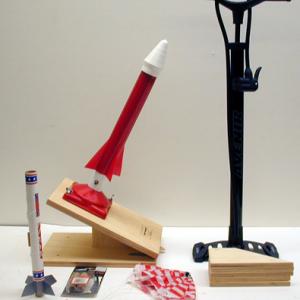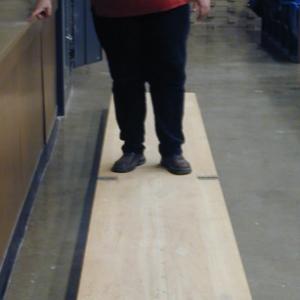College of Liberal Arts & Sciences
1N22.00 - Rockets
Video Credit: Jonathan M. Sullivan-Wood.
Connect the bicycle pump to the air powered rocket stand. Set the stand at the desired angle. Insert either the low, medium, high, or super thrust washer onto the stand and position the rocket. Start pumping with the bicycle pump and when the correct pressure is reached the rocket will launch automatically.
CAUTION: This rocket is capable of reaching 125 feet in altitude. The low trust washer is probably the one to use in the lecture rooms. Even then you will probably hit the ceiling.
NOTE: Make sure you aim this at an unoccupied portion of the lecture room!!
The platform may be used to show how a rocket works. Place several students on one end to act as the astronauts or payload. Have 4 or 5 students stand on the other end of the platform in a single line getting ready to step off the platform. As each student steps off the platform, the platform should be propelled in the opposite direction. Note that the "rocket" accelerates a little faster each time a student steps off.
NOTE: The solid fuel engine rockets can ONLY be used outdoors. Insert the desired engine in the rocket body and insert the cone with the parachute in the other end of the rocket. Ignite using the electric igniter which can be found with the rocket car (1H1030). Depending upon the rocket engine used up to 400 foot altitude is possible.
- Miguel Lagos, Milton Elgueta, Rodrigo Paredes, Mario I. Molina, "Waterways and Rocket-Propulsion Problems", TPT, Vol. 61, #8, Nov. 2023, p. 672.
- Miguel Lagos, Milton Elgueta, Mario I. Molina, "Chains, Conveyor Belts, and Rockets", TPT, Vol. 60, #8, Nov. 2022, p. 674.
- Philip Rodriguez Blanco and Carl E. Mungan, "Rocket Propulsion, Classical Relativity, and the Oberth Effect", TPT, Vol. 57, #7, Oct. 2019, p. 439.
- Dan Nichols, "Improved Baking Soda Vinegar Rocket", TPT, Vol. 56, #9, Dec. 2018, p. 611.
- Paul Hewitt, "Figuring Physics", TPT, Vol. 55, #1, Jan. 2017, p. 54.
- Matthew d'Alessio and Loraine Lundquist, "Computer Supported Collaborative Rocketry: Teaching Students to Distinguish Good and Bad Data Like Expert Physicists", TPT, Vol. 51, #7, Oct. 2013, p. 424.
- Wayne Keith, Cynthia Martin, and Pamela Veltkamp, "This Is Rocket Science!", TPT, Vol. 51, #6, Sept. 2013, p. 362.
- Brooke Hester and Jennifer Burris, "Another Look at Rocket Thrust", TPT, Vol. 50, #9, Dec. 2012, p. 534.
- Tarek A. Elsayed, "Interpreting Recoil for Undergraduate Students", TPT, Vol. 50, #4, Apr. 2012, p. 209.
- Philip Backman, "Maximum Aerodynamic Force on an Ascending Space Vehicle", TPT, Vol. 50, #3, Mar. 2012, p. 167.
- Dwain M. Desbien, "High-Speed Video Analysis in a Conceptual Physics Class", TPT, Vol. 49, #6, Sept. 2011, p. 332.
- Kim Penn and William V. Slaton, "Measuring Model Rocket Engine Thrust Curves", TPT, Vol. 48, #9, Dec. 2010, p. 591.
- Arthur Stinner and Don Metz, "The Flight of the Space Shuttle Discovery (STS-119)", TPT, Vol. 48, #3, Mar. 2010, p. 162.
- Thomas A. Dooling, "An Eight-Parameter Function for Simulating Model Rocket Engine Thrust Curves", TPT, Vol. 45, #5, May 2007, p. 280.
- Alan J. Scott, "Sand Diver", TPT, Vol. 43, #1, Jan. 2005, p. 48.
- Ken Horst, "Model Rocketry in the 21st-Century Physics Classroom", TPT, Vol. 42, #7, Oct. 2004, p. 394.
- Stephen A. Widmark, "Rocket Physics", TPT, Vol. 36, #3, Mar. 1998, p. 148.
- A. R. Marlow, "The Pedagogy of the Rocket", TPT, Vol. 33, #2, Feb. 1995, p. 124.
- Michael P. Jansen, "Using a Camcorder to Analyze Motion", TPT, Vol. 31, #4, Apr. 1993, p. 197.
- Randy A. Jenkins, "Colorized Version", TPT, Vol. 31, #4, Apr. 1993, p. 197.
- Randy A. Jenkins, "Measuring Model Rocket Acceleration", TPT, Vol. 31, #1, Jan. 1993, p. 10.
- Brian R. Page, "The Rocket Experiments of Robert H. Goddard, 1911 to 1930", TPT, Vol. 29, #8, Nov. 1991, p. 490.
- J. Matolyak and G. Matous, "Simple Variable Mass System: Newton's Second Law", TPT, Vol. 28, #5, May 1990, p. 328.
- David Keeports, "Numerical Calculations of Model Rocket Trajectories", TPT, Vol. 28, #5, May 1990, p. 274.
- Paul Buhse and Evan S. Snyder, "Two-Rocket Paradox", TPT, Vol. 27, #4, Apr. 1989, p. 292.
- Thomas R. Michalik, "Reference Frames and Orbital Rendezvous", TPT, Vol. 23, #6, Sept. 1985, p. 353.
- Peter Krumm, "Now, Where Does This Energy Come From?", TPT, Vol. 23, #4, Apr. 1985, p. 221.
- John Bair and F. Lee Slick, "Projective Motion on A Football Field", TPT, Vol. 21, #3, Mar. 1983, p. 198.
- Alfred Leitner, "The Effect of Atmosphere Pressure on Rocket Thrust - Part II", TPT, Vol. 20, #6, Sept. 1982, p. 479.
- Crispin O. Butler and Alfred Leitner, "The Effect of Atmosphere Pressure on Rocket Thrust - Part I", TPT, Vol. 20, #6, Sept. 1982, p. 410.
- R. B. Hastings, "Operation Rockets", TPT, Vol. 20, #2, Feb. 1982, p. 107.
- Mario Iona, "'Efficiency' in Rocket Propulsion", TPT, Vol. 16, #9, Dec. 1978, p. 600.
- Barrie Faulkner and Hugh D. Young, "Why the Difference in Energy?", TPT, Vol. 16, #6, Sept. 1978, p. 397.
- Mervin Brubaker, "Measuring the Thrust of a Model Rocket", TPT, Vol. 12, #8, Nov. 1974, p. 488.
- W. N. Martin, "Air-Rockets", TPT, Vol. 7, #8, Nov. 1969, p. 453.
- Robert F. Coutts, "Rocket Engine Analog", TPT, Vol. 7, #7, Oct. 1969, p. 407, also A Potpourri of Physics Teaching Ideas - Mechanics, p. 41.
- Richard M. Sutton, "An Introvert Rocket or Mechanical Jumping Bean", TPT, Vol. 1, #3, Sept. 1963, p. 108, also A Potpourri of Physics Teaching Ideas - Odds and Ends, p. 305.
- Robert H. Gowdy, "The Physics of Perfect Rockets", AJP, Vol. 63, #3, Mar. 1995, p. 229.
- Leo H. van denv Raadt, "Comment on 'Timely Equations of Rocket Motion and the Surprising Power of Rockets' by R. Stephenson [Am. J. Phys. 57, 322-325 (1989)]", AJP, Vol. 59, #11, Nov. 1991, p. 1048.
- K. T. McDonald, "Motion of a Leaky Tank Car", AJP, Vol. 59, #9, Sept. 1991, p. 813.
- Kent L. Gee, Caroline P. Lubert, Michael M. James, "The Roar of a Rocket", Physics Today, Vol. 77, #3, March 2024, p. 46.
- Mark Cappelli, "The Hall Effect and Rocket Flight", Physics Today, Vol. 62, #4, Apr. 2009, p. 76.
- Shawn Carlson, "The Amateur Scientist: Taking Back the Final Frontier", Scientific American, Vol. 227, #6, Dec. 1997, p. 114.
- Susan E. Matthews, "How To Turn A Match Into A Tiny Rocket [VIDEO]", Popular Science, Vol. 285, #7, July 2013, p. 82.
- Theodore Gray, "Gray Matter: Watch A Hybrid Rocket Burn From The Inside Out", Popular Science, Vol. 285, #3, Mar. 2013, p. 68.
- Don Pettit, "The Tyranny of the Rocket Equation", Ad Astra, Vol. 24, #3, Fall 2012, p. 20.
- Jearl Walker, "1.168, Rockets, and a Problem with an Iceboat", The Flying Circus of Physics Ed. 2, p. 76.
- Julien Clinton Sprott, Physics Demonstrations, "1.13, Rockets", ISBN 0-299-21580-6, p. 35.
- Bill Franklin, "Air Impulse Rocket and Launcher", Teaching About Impulse and Momentum, p. 3.6.
- Pat Murphy, Ellen Macaulay, and the staff of the Exploratorium, "Making a Rocket Launder", Exploratopia, p. 144.
- Martin Gardner, "Miniature Rocket", Science Tricks, p. 24.
- Tori Tellum & Andrew Schuth, "What It's Like to Drive a Jet Pack", Hotrod Magazine, May 2013, p. 18.
- Janice VanCleave, "Demonstrate How Earth's Rotation Affects Launching a Rocket into Space", Super Science Challenges, p. 29.
- Rick Beyer, "For the Record", The Greatest Science Stories Never Told, p. 186.
- Curt Suplee, "Newton II: Equal and Opposite", Everyday Science Explained, National Geographic, p. 20 - 21.
- Tik L. Liem, "The Straw Rocket", Invitations to Science Inquiry - Supplement to 1st and 2nd Ed. p. 134.
- Julius Sumner Miller, Q205 & A205, Millergrams II – Some More Enchanting Questions for Enquiring Minds, p. 60 & 110.
Disclaimer: These demonstrations are provided only for illustrative use by persons affiliated with The University of Iowa and only under the direction of a trained instructor or physicist. The University of Iowa is not responsible for demonstrations performed by those using their own equipment or who choose to use this reference material for their own purpose. The demonstrations included here are within the public domain and can be found in materials contained in libraries, bookstores, and through electronic sources. Performing all or any portion of any of these demonstrations, with or without revisions not depicted here entails inherent risks. These risks include, without limitation, bodily injury (and possibly death), including risks to health that may be temporary or permanent and that may exacerbate a pre-existing medical condition; and property loss or damage. Anyone performing any part of these demonstrations, even with revisions, knowingly and voluntarily assumes all risks associated with them.

